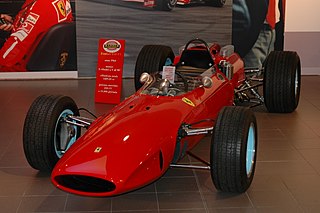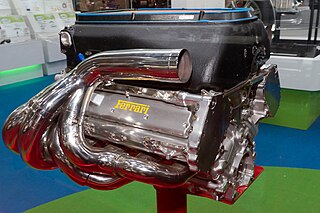Scuderia Ferrari S.p.A. is the racing division of luxury Italian auto manufacturer Ferrari and the racing team that competes in Formula One racing. The team is also known by the nickname "The Prancing Horse", in reference to their logo. It is the oldest surviving and most successful Formula One team, having competed in every world championship since 1950.

Formula Two is a type of open-wheel formula racing category first codified in 1948. It was replaced in 1985 by Formula 3000, but revived by the FIA from 2009–2012 in the form of the FIA Formula Two Championship. The name returned again in 2017 when the former GP2 Series became known as the FIA Formula 2 Championship.

Dino was a marque best known for mid-engined, rear-drive sports cars produced by Ferrari from 1957 to 1976. The marque came into existence in late 1956 with a front-engined Formula Two racer powered by a brand new Dino V6 engine. The name Dino was used for some models with engines smaller than 12 cylinders, it was an attempt by the company to offer a relatively low-cost sports car. The Ferrari name remained reserved for its premium V12 and flat-12 models until 1976, when "Dino" was retired in favour of full Ferrari branding.

The Porsche 804 is a single-seat, open-wheeled racing car produced by Porsche to compete in Formula One (F1). It raced for a single season in 1962 in the 1½ litre formula.
The Ferrari Dino engine is a line of mechanically similar V6 and V8 engines produced by Ferrari for about 40 years from the late 1950s into the early 2000s.
The Ferrari P was a series of Italian sports prototype racing cars produced by Ferrari during the 1960s and early 1970s.

The Ferrari 156 was a racing car made by Ferrari in 1961 to comply with then-new Formula One regulations that reduced engine displacement from 2.5- to 1.5-litres, similar to the pre-1961 Formula Two class for which Ferrari had developed a mid-engined car also called 156 F2.

The Ferrari 246 F1 is a Ferrari racing car built for the Formula One World Championship of 1958.

The Cooper T51 was a Formula One and Formula Two racing car designed by Owen Maddock and built by the Cooper Car Company for the 1959 Formula One season. The T51 earned a significant place in motor racing history when Jack Brabham drove the car to become the first driver to win the World Championship of Drivers with an engine mounted behind them, in 1959. The T51 was raced in several configurations by various entrants until 1963 and in all no less than 38 drivers were entered to drive T51s in Grand Prix races.

The Ferrari 158 was a Formula One racing car made by Ferrari in 1964 as a successor to the V6-powered Ferrari 156 F1.
The Ferrari 246 F1-66 was a racing car used by Scuderia Ferrari and Reg Parnell Racing during the 1966 Formula One season.

The Ferrari 212 F1 was a Formula 1 and Formula 2 racing car designed by Aurelio Lampredi for Scuderia Ferrari in 1951.

Vittorio Jano designed a new 60° V12 engine for sports car racing for Ferrari. This new engine, introduced in 1956, combined elements of both Colombo and Lampredi engines with new features. Engine architecture was more of Lampredi school but retained smaller Colombo internal measurements. Jano moved to Ferrari along with his designs for the Lancia D50 in 1955 and went on to design not only a new V12 but also a family of the Dino V6 engines soon after. Some of the technical ideas came from the Jano's Lancia V8 DOHC engine, intended for Formula One. This family of engines replaced Lampredi inline-4s known from Ferrari Monza line and went on to win many international races and titles for Ferrari. The design team comprised Jano as well as Vittorio Bellentani, Alberto Massimino, and Andrea Fraschetti.

The Ferrari SP was a series of Italian sports prototype racing cars produced by Ferrari during the early 1960s. All featured a rear mid-engine layout, a first for a Ferrari sports car. Major racing accolades include the 1962 European Hill Climb Championship, two overall Targa Florio victories, in 1961 and 1962, and "1962 Coupe des Sports" title.

The Ferrari 412 S was a unique sports racing car produced by Ferrari in 1958. The 412 S combined Ferrari's most powerful V12 engine to date with a one-off experimental racing chassis. It was also incorrectly called as the 412 MI due to being built around an engine from the 500 Miles of Monza racer. The car was created specifically for John von Neumann to take on the American racing cars Scarabs in SCCA racing. Its famed drivers included Phil Hill and Richie Ginther.

Ferrari manufactured a series of 3.0-litre, naturally-aspirated, V10 racing engines, exclusively for their Formula One race cars; between 1996 and 2005. They chose a V10 engine configuration, because it offered the best compromise between power and fuel efficiency; the V12 was powerful but thirsty while the V8 was weaker but economical. They switched to 2.4-litre naturally-aspirated V8 engine configuration for 2006. Over its decade-long evolution, power levels varied; from 715 hp @ 15,500 rpm in 1996, to over 900 horsepower, around 935 hp @ 19,000 rpm, toward the end of the 2005 season. The Tipo 05 series of engines, produced between 2001 and 2005, was officially stated to produce between 825 hp @ 17,800 rpm, and 865 hp @ 18,300 rpm. In qualifying mode, however, these engine were reputed to develop up to, or at times over, 900 horsepower (670 kW) at 19,000 rpm.

Ferrari has manufactured three naturally-aspirated V8 racing engines, designed for Formula One racing. First, the Tipo DS50 engine introduced in 1956; with the 2.5 L engine configuration. Second, the Tipo 205/B engine, introduced in 1964; with the 1.5 L engine configuration; and was designed by Franco Rocchi and Angelo Bellei. Then, a 42-year hiatus; until the FIA imposed a 2.4 L engine V8 configuration for all Formula One teams in 2006, with Ferrari introducing their Tipo 056; designed by Gilles Simon.
Ferrari made four naturally-aspirated V6 racing engines designed for Formula One; between 1958 and 1966. The Formula One regulations for 1954–1960 limited naturally aspirated engines to 2500 cc, and for the 1958 season, there was a change from alcohol fuels to avgas. The 246 F1 used a 2,417.34 cc Dino V6 engine with a 65° angle between the cylinder banks. The power output was 280 PS at 8500 rpm. Bore X Stroke: 85 mm × 71 mm This was the first use of a V6 engine in a Formula One car, but otherwise the 246 F1 was a conventional front-engine design. The Ferrari 246 F1 was good enough to win a World Championship for Mike Hawthorn and a second place in the Constructors' Championship for Ferrari.

The Ferrari 166 F2 is an open-wheel formula racing single-seater car, designed, developed and built by Italian manufacturer and team Scuderia Ferrari, for Formula 2 racing, in 1948. This is the car in which Argentinian driver, and eventual five-time Formula One world champion, Juan Manuel Fangio, became known in Europe.

The Ferrari Dino 166 F2 was an open-wheel Formula 2 race car, designed, developed, and built by Italian racing team Scuderia Ferrari, in 1967. A total of seven models were manufactured and produced.















